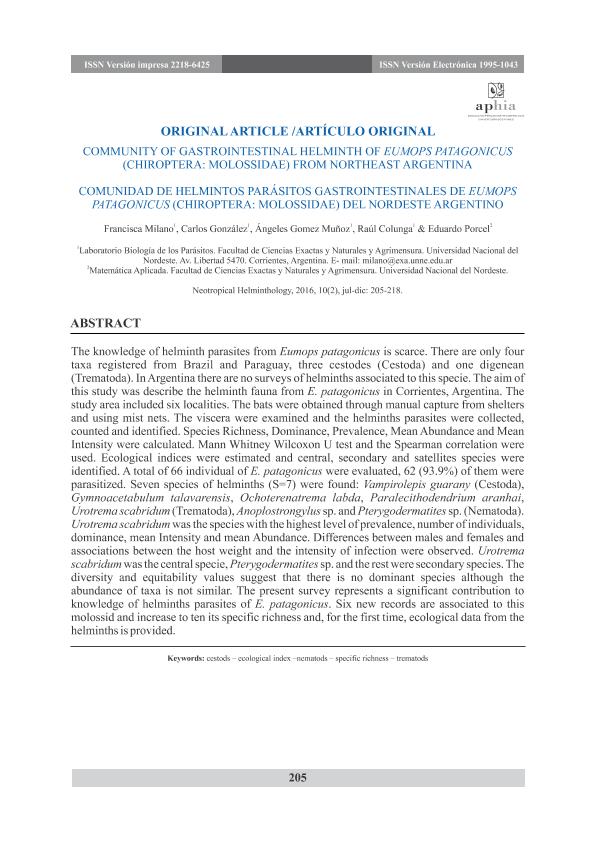Artículo
El conocimiento de los helmintos parásitos de Eumops patagonicus es escaso, se registran solo cuatro taxones de helmintos en Brasil y Paraguay, tres cestodes (Cestoda) y un digeneo (Trematoda). En Argentina no existen estudios sobre helmintos asociados a esta especie. El objetivo del presente trabajo fue describir la helmintofauna de E. patagonicus de Corrientes,Argentina. El área de estudio comprendió seis localidades. Los murciélagos se obtuvieron mediante captura manual de refugios y utilizando redes de niebla. Se examinaron las vísceras y se colectaron, contabilizaron e identificaron los helmintos parásitos. Se calculó riqueza de especies,especie dominante, prevalencia, abundancia media e intensidad media. Se utilizaron el test U de Mann Whitney Wilcoxon y la correlación de Spearman. Se estimaron índices ecológicos y seidentificaron especies centrales, secundarias y satélites. Se evaluaron 66 individuos de E. patagonicus, de los cuales 62 (93,9%) presentaron helmintos parásitos. La riqueza fue igual a siete especies: Vampirolepis guarany (Cestoda), Gymnoacetabulum talavarensis, Ochoterenatrema labda, Paralecithodendrium aranhai, Urotrema scabridum (Trematoda), Anoplostrongylus sp. y Pterygodermatites sp. (Nematoda). Urotrema scabridum fue la especiede mayor prevalencia y número de individuos, siendo la especie dominante, de mayor intensidad y abundancia medias. Se observaron diferencias entre machos y hembras y asociaciones entre el peso del hospedador y la intensidad de infección. Se identificó U. scabridum como especie central, Pterygodermatites sp. como satélite y las demás como especies secundarias. Los valoresde diversidad y equitabilidad sugieren que no existe una especie dominante aunque la abundancia de los taxa no es similar. El presente trabajo representa un significativo aporte al conocimiento de los parásitos de E. patagonicus ya que se adicionaron seis nuevos registros de helmintos asociados a este molósido, elevando a diez su riqueza específica y por primera vez se brindandatos ecológicos de sus helmintos. The knowledge of helminth parasites from Eumops patagonicus is scarce. There are only four taxa registered from Brazil and Paraguay, three cestodes (Cestoda) and one digenean (Trematoda). In Argentina there are no surveys of helminths associated to this specie. The aim of this study was describe the helminth fauna from E. patagonicus in Corrientes, Argentina. The study area included six localities. The bats were obtained through manual capture from shelters and using mist nets. The viscera were examined and the helminths parasites were collected, counted and identified. Species Richness, Dominance, Prevalence, Mean Abundance and Mean Intensity were calculated. Mann Whitney Wilcoxon U test and the Spearman correlation were used. Ecological indices were estimated and central, secondary and satellites species were identified. A total of 66 individual of E. patagonicus were evaluated, 62 (93.9%) of them were parasitized. Seven species of helminths (S=7) were found: Vampirolepis guarany (Cestoda), Gymnoacetabulum talavarensis, Ochoterenatrema labda, Paralecithodendrium aranhai, Urotrema scabridum (Trematoda), Anoplostrongylussp. and Pterygodermatitessp. (Nematoda). Urotrema scabridum was the species with the highest level of prevalence, number of individuals, dominance, mean Intensity and mean Abundance. Differences between males and females and associations between the host weight and the intensity of infection were observed. Urotrema scabridum was the central specie, Pterygodermatitessp. and the rest were secondary species. The diversity and equitability values suggest that there is no dominant species although the abundance of taxa is not similar. The present survey represents a significant contribution to knowledge of helminths parasites of E. patagonicus. Six new records are associated to this molossid and increase to ten its specific richness and, for the first time, ecological data from the helminths is provided.
Comunidad de helmintos parásitos gastrointestinales de Eumops patagonicus (Chiroptera: Molossidae) del Nordeste Argentino
Título:
Community of gastrointestinal helminth of Eumops patagonicus (Chiroptera: Molossidae) from Northeast Argentina
Milano, Alicia María Francisca; González, Carlos Andrés ; Gómez Muñoz, María de Los Ángeles
; Gómez Muñoz, María de Los Ángeles ; Colunga, Raúl Rubén; Porcel, Eduardo Adolfo
; Colunga, Raúl Rubén; Porcel, Eduardo Adolfo
 ; Gómez Muñoz, María de Los Ángeles
; Gómez Muñoz, María de Los Ángeles ; Colunga, Raúl Rubén; Porcel, Eduardo Adolfo
; Colunga, Raúl Rubén; Porcel, Eduardo Adolfo
Fecha de publicación:
12/2016
Editorial:
Asociación Peruana de Helmintología e Invertebrados Afines
Revista:
Neotropical Helminthology
ISSN:
2218-6425
e-ISSN:
1995-1043
Idioma:
Español
Tipo de recurso:
Artículo publicado
Clasificación temática:
Resumen
Palabras clave:
CESTODES
,
INDICES ECOLOGICOS
,
NEMATODES
,
RIQUEZA ESPECIFICA
Archivos asociados
Licencia
Identificadores
Colecciones
Articulos(CCT - NORDESTE)
Articulos de CTRO.CIENTIFICO TECNOL.CONICET - NORDESTE
Articulos de CTRO.CIENTIFICO TECNOL.CONICET - NORDESTE
Citación
Milano, Alicia María Francisca; González, Carlos Andrés; Gómez Muñoz, María de Los Ángeles; Colunga, Raúl Rubén; Porcel, Eduardo Adolfo; Comunidad de helmintos parásitos gastrointestinales de Eumops patagonicus (Chiroptera: Molossidae) del Nordeste Argentino; Asociación Peruana de Helmintología e Invertebrados Afines; Neotropical Helminthology; 10; 2; 12-2016; 5-12
Compartir
Altmétricas



